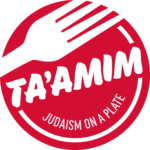3-courses featuring all the edible components of the Seder Plate
The heart of the Pesach table, the Seder plate is filled with symbolism and meaning. Pesach is the most observed Jewish festival, and if you have attended numerous Sedarim over the years, the Seder plate is likely to also hold nostalgia and, in essence tells its own story, one directly relating to each individual and all the memories of Passovers before.
The Seder itself is immersive, and we are instructed to commemorate the Chag by eating ‘Pesach, Matzah and Marror,’ (though, of course, we are unable to eat the Pesach, the Passover offering, until the Temple is rebuilt). Still, by their very nature, the flavours of the Seder connect us to the long line of thousands of Seders in millions of homes and all the way back to the Exodus from Egypt. Marror, Karpas dipped in saltwater, each family’s own twist on Charoset, the eggs, matzot and wine – even boiled potatoes… each evokes a certain something in each of us. We bring these flavours through the meal itself to connect the Shulchan Orech, the main meal, to the story and other rituals of of the night, (whilst also using up some of those extra ingredients for cost-effective Pesach shopping).

We begin our meal with a horseradish (marror) and parsley (karpas) crusted salmon. If you buy a large fresh horseradish, the leftovers often languish in the fridge long after Pesach has finished, but there are plenty of ways to make use of it. Aside from making a delicious addition to mash potato, or paired with roast beef, grated horseradish can add a wonderful kick to citrus dishes, and this fishy first course is no exception. With the vibrancy of zesty lemon and the freshness of the herbs cutting through the bitterness, this salmon starter is wonderfully well-rounded.

We continue with a sweet and savoury second course with a Charoset-stuffed chicken breast with potato purée. This rolled chicken ballotine is easy to make but sure to impress your guests. We’ve combined Ashkenazi, Sephardi and Mizrahi Charoset traditions, with the sweet stickiness of dates, the tartness of apple and the crunch of walnut. The added depth from the umami of onion brings this Pesach favourite to a new dimension. The chicken is then poached in wine (or stock), a nod to the wine in Ashkenazi Charoset, to the four cups we drink at the Seder, and to the one we leave for Eliyahu HaNavi. This is served with a sumptuous, thick potato puree (obviously cooked in plenty of salt water)! We recommend finishing this course with a sweetheart cabbage and celery slaw, or our Seder Plate Salad, featuring even more elements from the heart of the Seder table.

The meal concludes with the one remaining food we are instructed to eat at the Seder – Matzah. A delicious Chocolate Torte with a crunchy, crumbly matzah crust is the perfect indulgent hit at the end of the meal that cries “I’m free!” and nods to the Afikoman with which we officially conclude the Shulchan Orech. Of course not everyone will make this because it contains Gebrokts, but the chocolate ganache is a delicious treat on its own. Alternatively, try our Chocolate Mousse Cake With Dark Fruits & Strawberry Coulis, the final dish in our of our Immersive 10 Plagues Seder Menu.
For those of you crying “what about the egg?” – It’s in the ganache, but nobody will stop you eating your boiled egg in saltwater as an amuse bouche if that’s your custom! You are free! Enjoy your freedom. Have a Chag Kasher v’Sameach! Happy Pesach.


